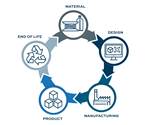What Is the Circular Economy, and How Can 3D Printing Help? (Video)
What does it mean to be sustainable, to manufacture in a circular economy? And where does 3D printing fit? These questions and more answered in this video, the first of our 3D Printing and the Circular Economy series.
How does manufacturing become sustainable? How do we harmonize our production and consumption to reduce waste and keep resources in play for as long as possible?
The answer lies in the circular economy, a concept that describes an ongoing cycle of manufacturing in which used materials, scrap and waste are constantly fed back into the system. The idea takes cues from the regenerative natural world, but applies them to these manmade systems.
Additive manufacturing (AM) and 3D printing technology will be key to establishing a circular economy. All next week, we’ll be posting short, bite-sized videos about each aspect of the circular economy — Material, Design, Manufacturing, Product and End-of-Life — and explore how 3D printing can advance and support more sustainable manufacturing. This initial video explains the circular economy and what it means to be sustainable in more depth; tune in next week for the topic-by-topic breakdown and join the conversation on social media using the hashtag #CircularEconomyWeek.
Resources and Related Links
- Videos in this series: What Is the Circular Economy? | Materials | Design | Manufacturing | Product | End-of-Life
- How Additive Manufacturing Will Aid and Accelerate the Circular Economy
- Why AM and Sustainability Go Together
- Latest stories on sustainability in additive manufacturing
Transcript
Manufacturing needs to change. We need more secure supply chains and more sustainable operations. 3D printing can help.
I’m Stephanie Hendrixson with Additive Manufacturing Media and The Cool Parts Show, and I want to introduce you to our video series on 3D printing and the circular economy. We’ll be bringing you bite-sized videos about each aspect of the circular economy and how it relates to 3D printing and additive manufacturing.
But first, a couple of definitions. What is sustainability? Being sustainable means doing thins in a such a way that allows them to carry on for as long as possible. It’s an ongoing, continuous cycle. The circular economy takes that idea and applies it to our cycles of production and consumption.
You can think about it in contrast to the linear economy, where we take materials, turn them into products, and then those products eventually get discarded. It’s a very clear beginning, middle and end. On the other hand, the circular connects all these things in this continuous, ongoing cycle. The material that’s in play stays in play for as long as possible.
We’ll talk about every aspect of the circular economy in the videos that follow, so if you're interested in learning more, keep watching.
Related Content
-
Alquist 3D Looks Toward a Carbon-Sequestering Future with 3D Printed Infrastructure
The Colorado startup aims to reduce the carbon footprint of new buildings, homes and city infrastructure with robotic 3D printing and a specialized geopolymer material.
-
BMW Expands Use of Additive Manufacturing to Foster Production Innovations
The BMW Group is manufacturing many work aids and tools for its own production system using various 3D printing processes, with items such as tailor-made orthoses for employees, teaching and production aids, and large, weight-optimized robot grippers, which are used for such things as carbon fiber-reinforced polymer roofs and entire floor assemblies.
-
Machine Tool Drawbar Made With Additive Manufacturing Saves DMG MORI 90% Lead Time and 67% CO2 Emission
A new production process for the multimetal drawbar replaces an outsourced plating step with directed energy deposition, performing this DED along with roughing, finishing and grinding on a single machine.

.jpg;width=70;height=70;mode=crop)









